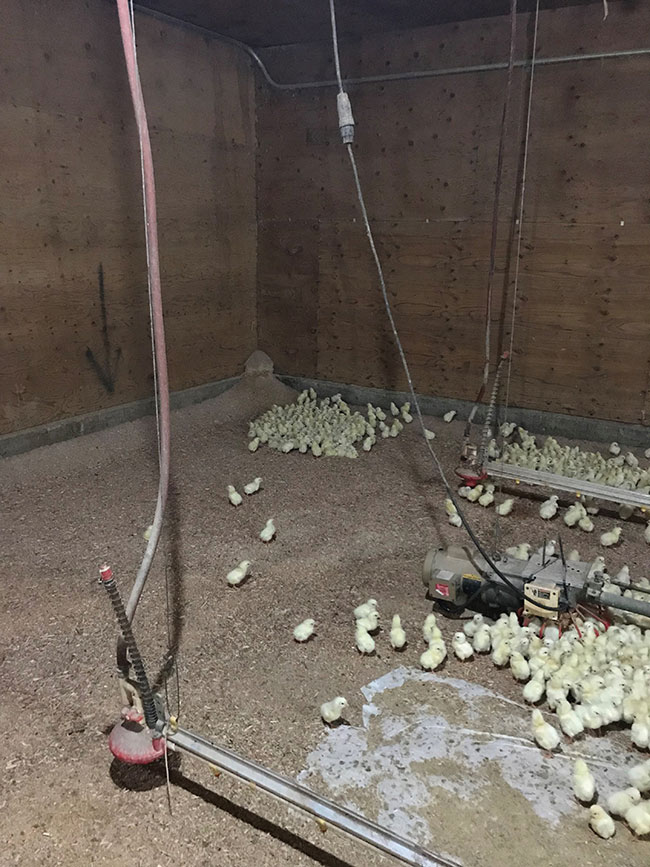
The Brooding Notebook Case Report: Huddling Poults
By Dr. Gigi Lin
Features TurkeysA conventional turkey grower called the veterinarian to consult about a flock of seven-day-old poults that suddenly experienced an increase in mortality, signs of lethargy and a decrease in feed intake. Here's what the veterinarian discovered.
 Elevated CO2 levels can cause chicks to huddle as their metabolism slows down, leading to reduced feed and water intake.
PHOTO CREDIT: Dr. Gigi Lin
Elevated CO2 levels can cause chicks to huddle as their metabolism slows down, leading to reduced feed and water intake.
PHOTO CREDIT: Dr. Gigi Lin On a cold Christmas Day, a conventional turkey grower called to consult about a flock of seven-day-old poults. Over the past 48 hours, the flock experienced an increase in mortality, signs of lethargy and a decrease in feed intake.
A field visit was arranged, and the necropsy findings indicated gross lesions consistent with starvation: dehydrated birds; off-feed; empty crops with gizzards filled with litter; and distended gall bladders.
Upon entering the barn, the poults were quiet and inactive. Many birds were found huddled in groups throughout the barn. A comprehensive assessment was conducted, systematically evaluating temperature, feed, litter, air quality, water availability, and sanitation (TFLAWS).
The poults were provided with adequate feed and water supply. The air and litter temperatures were within the expected range, with no discernible drafty or cool spots detected under the infrared camera. However, the most significant finding was the elevated carbon dioxide (CO2) levels, with readings ranging from 3,500 to 4,500ppm throughout the barn.
Impact of elevated CO2 levels
Carbon dioxide in poultry barns is often generated by normal combustion processes and bird respiration. The build-up of CO2 levels are particularly prevalent in under-ventilated barns, especially during the winter season.
When the concentration of CO2 exceeds 2,500 to 3,000 ppm, the adverse effects on bird behaviour becomes obvious. Poults may display signs of lethargy, drowsiness, and huddling behaviour, as their metabolism slows down – this behaviour can also be observed in flocks exposed to cold temperatures.
Subsequently, these birds reduce their feed and water intake, leading to an increase in mortality due to starvation in chronic cases. Long-term exposure to high CO2 levels can negatively impact gut health, flock uniformity, and overall flock performance, ultimately impeding growth rates.
Turkey, in particular, is more susceptible to high CO2 level. Studies have shown that carbon dioxide levels above 2,500ppm of were linked to significant spontaneous cardiomyopathy, also known as round heart disease.(1)
Therefore, during colder months, it is important to strike a balance between energy costs and ensuring sufficient fresh air flow.
Intervention and clinical outcomes
Following the consultation, the ventilation and heat systems were adjusted. Additional creep feed was placed on chick paper to facilitate easier access to feed.
The next day’s follow-up phone call showed that the birds had returned to normal behaviour. The flock was bright and alert, and evenly distributed throughout the barn. The feed and water consumption levels also returned to normal. The grower expressed his intention to install a CO2 meter for continuous
monitoring.
This case shows that birds exposed to environmental challenges usually recover well if the underlying cause are corrected promptly.
On-demand webinar
Looking for more from Dr. Gigi Lin? A webinar she delivered for our Broiler School series outlining case-based reviews of brooding best practices is now available on-demand at canadianpoultrymag.com. The series also includes experts speaking about emerging diseases, gut health in a post-antibiotic world and biosecurity best practices.
Reference:
1. Frame, D. D., Buckner, B. E, and Anderson, G. L. Causes and Control of Spontaneous Cardiomyopathy or Roundheart Disease in Utah Turkeys. Utah State University Extension. 1999
Dr. Gigi Lin is a board-certified poultry veterinarian. She provides diagnostic, research, consultation, continuing education, and field services to all levels of the poultry industry in Western Canada. In this column, she will share case-based reviews of brooding best practices.
Print this page